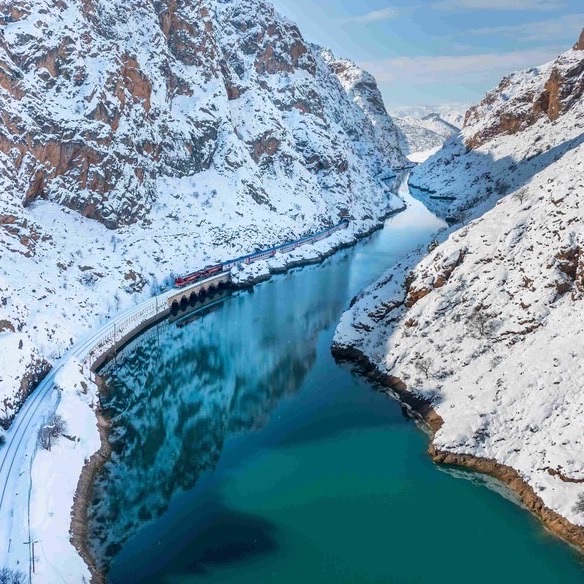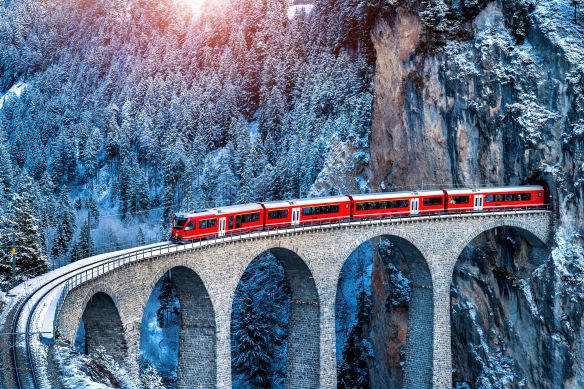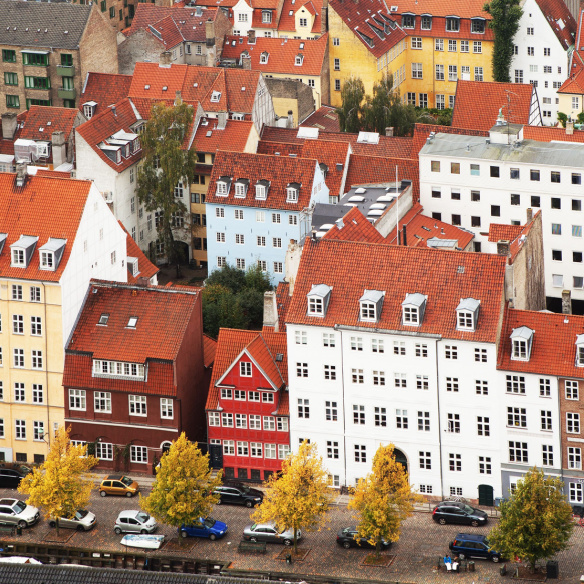
A local's guide to Abisko, one of the world's best places to see the northern lights
Rachel Schnalzer
26 September 2024
When Aril Petersson first travelled north to Abisko, Sweden, he planned to work there for one winter season, hoping to ski as much as possible during his free time.
Instead, he ended up staying for 12 years – and counting.
“Basically, I fell in love with this place,” said Aril, the owner of Abisko Adventure, an outdoor guide company that specialises in ice climbing excursions and offers hiking and snowshoeing tours in the northern Swedish wilderness.
Abisko, 200 kilometres north of the Arctic Circle, is one of the best places in the world to see the northern lights. But Aril emphasises there are plenty of daytime activities to attract travellers, too.
“In winter, we have skiing, snowshoeing and, of course, ice climbing. And at night, you will see the auroras,” he said. “During summer, we have the midnight sun – the sun doesn't set here for a month.”
Abisko is easily accessible by train, situated between Kiruna, Sweden and Narvik, Norway. Provided there are no train disruptions, Interrail and Eurail travellers can use the Global Pass to take the Norrland Night Train from Stockholm to Abisko and beyond.
But despite its ease of accessibility, the small community of Abisko – with a population of roughly 100 residents – feels like a world away from Narvik and Kiruna, each under two hours away by train.
“It’s a super small village, and nature is really close by,” said Aril, who is also a certified avalanche technician and wilderness first responder.
“In the village, right now, we have a moose mother with her calf, wandering around. That's nature TV at its best.”
On a recent visit to Abisko, a few Eurail colleagues and I caught up with Aril to learn about ice climbing, life in Abisko, and how travellers can make the most of a trip to the north of Sweden.
This conversation has been condensed and edited for length and clarity.
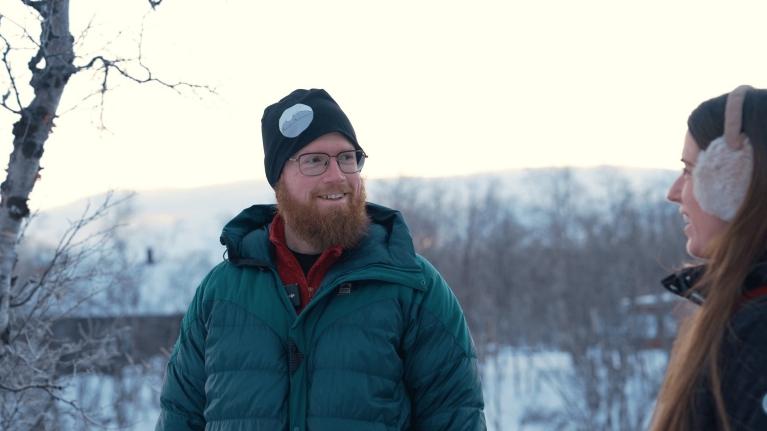
Aril Petersson speaking with Rachel Schnalzer, senior writer at Eurail

The northern lights flicker over Abisko, Sweden

An ice climber scales a wall of ice in Abisko, Sweden (credit: Aril Petersson)
What made you fall in love with Abisko?
So, I came to Abisko 12 years ago to be able to do winter sports for longer periods of time. I had done a lot of skiing before, and I had just started doing ice climbing.
This place is a superb place to ice climb, especially on natural ice. It has one of the longest ice climbing seasons, lasting about six months.
What are your favourite spots to go ice climbing in Abisko?
If you're a total beginner, the canyon near the STF Turiststation is a really good place. It’s easily accessible, and the climb is not too high and won’t be too intimidating. Even if you’re afraid of heights, you can climb up and stop at your own limit.
If you're more experienced, I can take you on a more challenging climb.
Describe your perfect day in Abisko
Well, it's going to be a winter day, probably in March. I’ll wake up early, pack my snowmobile, go out in the mountains, and from there, I’ll do some ski mountaineering.
Later, I’ll have dinner at Abisko Mountain Lodge and order either the Arctic Char (a locally caught fish) or a reindeer dish.
What’s your favourite month in Abisko, besides the snowy ones?
I would say September, when Abisko’s trees are painted in shades of yellow, orange and red. It's a little bit colder then, compared to the summer, but it’s perfect.
We’ve seen the most beautiful pink dawns and dusks here in Abisko. Where are your favourite places to enjoy sunrise or sunset?
There’s a place called the “Viewpoint of Abisko” behind the village. In winter, it takes about 40 minutes to hike up there; in summer, it takes maybe 20 minutes. This gives you a nice shot of the town.
What is your favourite summer hike in Abisko?
I recommend hiking up to Paddus. It’s a day hike that will take you halfway up to Tjuonavagge, the U-shaped valley you can see from Abisko.
You get an astonishing view from up there and can see the lake and the land around Abisko.
What do travellers typically miss when they come to Abisko?
I would say many travellers don’t plan to spend enough days here. Most of them come for one or two nights to see the auroras, but if the weather is unfavourable, you can miss it.
Plus, there are a lot of things to do here in addition to the auroras. It’s a great place for photography, and there are a lot of sports you can do here, but you just need the time to do it.
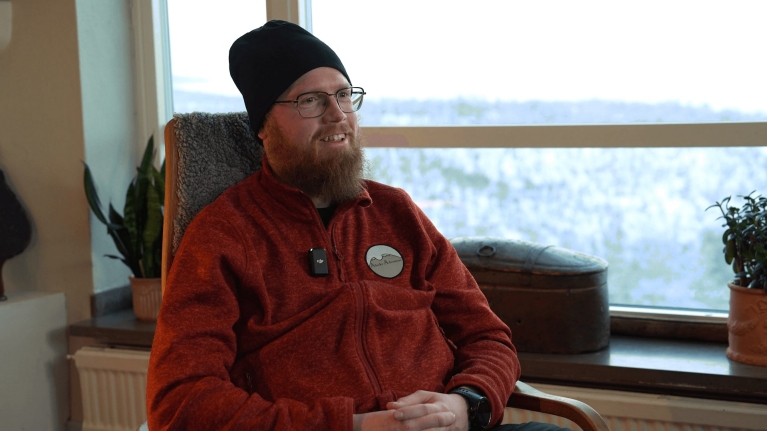
One of Aril's tips for a successful trip to Abisko? Stay at least 4 or 5 days.
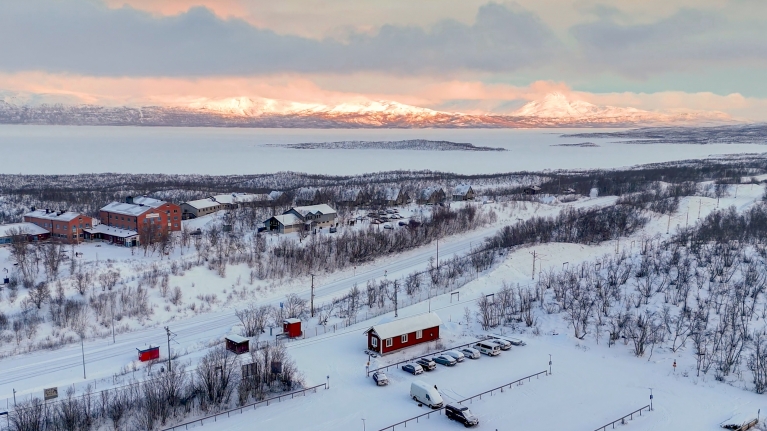
Abisko can easily be reached by night train from Stockholm

Abisko is an ideal destination for ice climbers of every skill level (credit: Aril Petersson)
How long would you typically recommend travellers stay in Abisko?
At least four or five days.
If you had a friend visit Abisko for four or five days, what activities would you take them to do?
Of course, ice climbing. There would also be some cross-country skiing, and later in the season when the ski resorts open, one day of downhill skiing. We’d try some off-piste as well.
Next, we’d do one day of snowmobiling, combine that with ice fishing and stay one night out in a mountain cabin. If you pack in any more, then it's too much.
What do Abisko locals wish tourists knew?
It would be good if more tourists knew that moose are actually dangerous – I see groups walking way too close to them.
The moose is a wild animal, and if they get irritated, they can easily harm you.
You're an avalanche technician and first responder. What is your advice for staying safe in Abisko?
Stay off steep slopes. And stay off frozen streams – even if it's really cold here, the streams are risky because you don’t really know how thick the ice is. You can walk on the frozen lake, but the streams, no.
And, of course, if it’s like -30 degrees, make sure to dress accordingly.
Any tips for staying warm on a winter visit to Abisko?
Most accommodations in Abisko offer some kind of rental wear – boots, warm clothing, etc. If you're going to be outside in the cold for a long time, put heaters into your boots and gloves.
As for your face, you can use a covering, but eventually you get used to the cold.
It’s the same for me every winter – it takes a couple of days for me to get used to the cold, but you endure it.
What is your favourite train journey from Abisko?
You should take the train down to Narvik, over the border in Norway. It’s one of the most beautiful train rides. The best part of the journey is when you come down through the Rombaken fjord.
You were a newcomer to Abisko 12 years ago. From your perspective, what is the best way to find community here?
Anyone hoping to build community should work at one of the bigger hotels in Abisko for a season. That's, by far, the easiest way to join the local community.
People also arrange group activities every week in the gym, such as circuit training or sports games. There, you get to know the locals.
If you were to describe Abisko as a feeling, what would it be?
Abisko feels very cosy. The feeling of being outside, experiencing nature and the cold, and then coming inside and having a chat with someone. Yeah, it is very cosy.

An ice climbing lesson run by Abisko Adventure (credit: Aril Petersson)
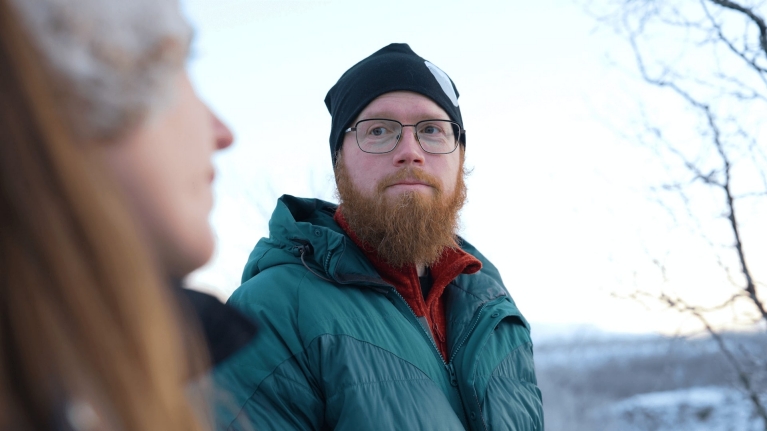
When Aril first arrived in Abisko, he planned to stay for only one winter season. Now, he's called Abisko home for over a decade.
Watch our full interview

Meet the writer
Rachel Schnalzer is a senior writer at Eurail, based in Utrecht, the Netherlands.
Favourite moment of the journey to Abisko
"Waking up on the night train from Stockholm to Abisko was pure magic. The morning light cast a pink glow over the whole landscape, and I loved watching the snow-covered forest from my train window while sipping coffee. To me, this experience was equally as special as seeing the northern lights."
Change of currency
You cannot change the currency once you have a Pass in your cart. Remove the Pass, and then change the currency on the website header.

